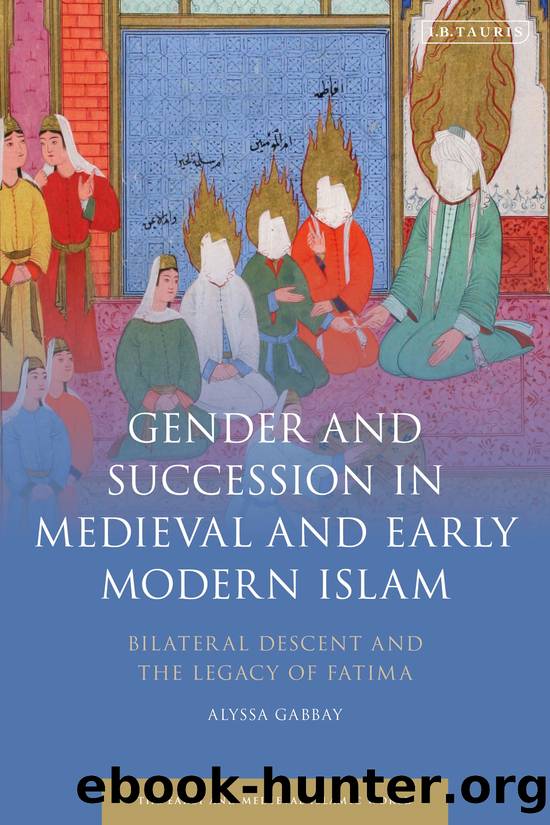Gender and Succession in Medieval and Early Modern Islam by Alyssa Gabbay;

Author:Alyssa Gabbay;
Language: eng
Format: epub
ISBN: 9781838602338
Publisher: Bloomsbury UK
Figure 5.2 Twentieth-century poster by Iranian artist Mohammad KhazÄâÄ« depicting Fatima as a soldier. © Peter J. Chelkowski.
The role of pre-Islamic practices
As with the images of her perpetuating her lineage and inheriting her fatherâs property, a number of factors likely played a part in medieval and early modern Shiâi depictions of Fatima as an authoritative figure and successor. Given her close ties to the imams, exalting her status was a necessary corollary of dignifying her children.110 Yet, just as with lineage and inheritance, pre-Islamic practices likely also paved the way for Fatima to be seen in this light. In this section, I look at concepts of female succession in Iran, the Byzantine Empire and pre-Islamic Arabia as a means of exploring potential influences.
As has already been suggested, daughters held a rather ambiguous status in pre-Islamic Iran. On the one hand, they were encouraged to be submissive and obedient, as evidenced by Zoroastrian scripture. On the other, women did possess many rights, and several famous examples exist of daughters who were lauded for their bravery and virtue, and who either represented their fathers well in the public sphere or succeeded their fathers to important positions. Tracing direct influence from these cases upon Shiâi depictions of Fatima is difficult, but it is likely that they smoothed the path among Iranians and others for acceptance of the idea of a daughter as more than merely a paragon of domesticity.
Like many later Islamic texts, Zoroastrian scripture tended to look upon females with a somewhat wary eye, seeing them as deficient in reason and therefore more prone to falling prey to evil than men: they were considered âweak willed, easily tempted, and led astray by the devilâs hordeâ.111 Though not inherently evil, women had to conform closely to the standards set by the virtuous feminine spirits in order to be good, which entailed being pious, devoted and obedient to the dominant men in their lives. Consequently, their ability to act as fully fledged successors and as competent entities in the public sphere was limited. For example, their inherent deficiency and greater susceptibility to pollution rendered them unfit to rule or take part in many priestly activities. Indeed, women who stepped out of the domestic sphere to take on public roles could be associated with the âevil female spirits who spread disorderâ.112 Inevitably, disasters âwere thought to occur when the female gender was permitted to exercise authority and make decisionsâ.113 The ideal role of woman as subservient to men emerges in an early Zoroastrian text which has been identified as a possible wedding sermon delivered by Zoroaster for his daughter, Pouruchista, to a seer. It states, âIndeed, I shall unite in marriage her among you, she who will serve father, husband, pastor, and family.â114
Despite their secondary status and inherent deficiencies as presented in Zoroastrian texts, however, in practice women enjoyed some rights, and at times royal women took on notably public and powerful roles. The Sassanian period presents a typically mixed portrait. Sassanian women were traditionally
Download
This site does not store any files on its server. We only index and link to content provided by other sites. Please contact the content providers to delete copyright contents if any and email us, we'll remove relevant links or contents immediately.
Cecilia; Or, Memoirs of an Heiress — Volume 1 by Fanny Burney(32440)
Cecilia; Or, Memoirs of an Heiress — Volume 2 by Fanny Burney(31875)
Cecilia; Or, Memoirs of an Heiress — Volume 3 by Fanny Burney(31858)
The Great Music City by Andrea Baker(31531)
We're Going to Need More Wine by Gabrielle Union(18973)
All the Missing Girls by Megan Miranda(15595)
Pimp by Iceberg Slim(14399)
Bombshells: Glamour Girls of a Lifetime by Sullivan Steve(13979)
Talking to Strangers by Malcolm Gladwell(13233)
Norse Mythology by Gaiman Neil(13215)
Fifty Shades Freed by E L James(13163)
For the Love of Europe by Rick Steves(13107)
Mindhunter: Inside the FBI's Elite Serial Crime Unit by John E. Douglas & Mark Olshaker(9209)
Crazy Rich Asians by Kevin Kwan(9173)
The Lost Art of Listening by Michael P. Nichols(7412)
Enlightenment Now: The Case for Reason, Science, Humanism, and Progress by Steven Pinker(7242)
The Four Agreements by Don Miguel Ruiz(6640)
Bad Blood by John Carreyrou(6558)
Weapons of Math Destruction by Cathy O'Neil(6152)
